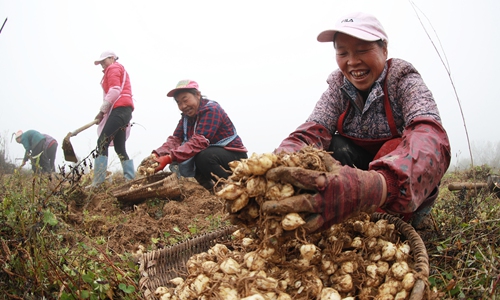HOME >> SOURCE
Guizhou Province offers high pay to specialists in poverty reduction
Source:Global Times Published: 2019/12/2 20:43:40

Villagers harvest lilies in Bijie, Southwest China's Guizhou Province, on Wednesday. They are poverty-stricken households and can earn 100 yuan ($14.2) a day working at the Chinese herbal plantation base. The plantation has helped 61,698 villagers emerge from poverty in recent years, media reports said. Photo: VCG
Southwest China's Guizhou Province is offering up to 500,000 yuan ($71,100) in annual salaries to attract specialists for poverty alleviation, which an analyst said on Monday will greatly contribute to poverty reduction in the province.
According to the plan released by the Science and Technology Department of Guizhou Province, the province will recruit 480 full-time professional science and technology specialists nationwide to work as science and technology commissioners in 16 impoverished counties.
This is the first time that Guizhou Province has recruited full-time science and technology commissioners. Ideal candidates shall have more than five years of technical experience and they will work full-time for one to two years in industrial counties and townships.
Attractive salaries will be provided to successful candidates, with the chief science and technology commissioner's annual salary at 500,000 yuan and ordinary commissioners' annual salary at 100,000 yuan.
Li Yurong, of the Guizhou Academy of Agricultural Science, told the Global Times on Monday that recruiting experts with high salaries is a good example of making every penny count. "This will greatly mobilize the enthusiasm and initiative of science and technology commissioners, so that they can devote themselves to the frontline of poverty alleviation," Li said, adding that this is an innovative approach by the government and it may accelerate poverty alleviation efforts.
The Guizhou government decided to give the total 160 million yuan in funding to implement a campaign to support science and technology in 12 industries with distinctive features, aiming to launch a profound industrial revolution to revitalize the rural economy, according to the Science and Technology Daily's report on November 29.
Posted in: ECONOMY